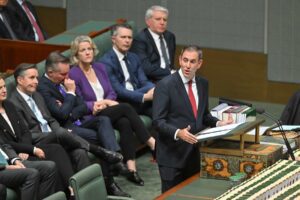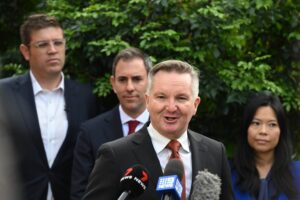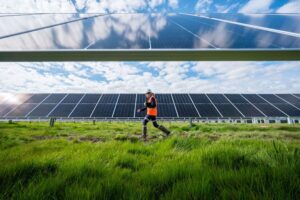Little wonder there was a walkout by attendees at a Brisbane solar and storage conference this week in the middle of a speech delivered by the federal Coalition’s energy spokesman Ted O’Brien. Every day the Opposition digs itself ever deeper into an anti-renewable, nuclear fanboy policy hole. And they insist it’s not about ideology.
The Coalition, through the Nationals, have made it clear that they intend to bring the roll out of large scale wind, solar and storage, and new transmission lines, to a halt. And Nationals leader David Littleproud has vowed to rip up contracts signed by the Commonwealth in its Capacity Investment Scheme if the Coalition ever wins power.
That threat would take economic destruction to a new and unprecedented level, beyond the Coalition’s scrapping of the carbon price and its attempts to do the same to the renewable energy target.
But the intent is clear: It is to use threats, fear tactics and right wing media to try and make big institutions think twice about investing in Australia. And truth and honesty is the first casualty.
“My fear is that by 2030, and certainly by 2035, our traditional manufacturing sector will be in ruin and blackouts and brownouts in our homes will be the norm,” O’Brien told attendees at the Brisbane conference, according to a transcript posted on his website.
O’Brien’s assessment is based on a series of deliberately false assumptions. The first is that is that the renewables transition cannot be done, for technical reasons, because a reliable energy supply can only be delivered with “baseload” and “always on” 24/7 power.
O’Brien claims he is not being ideological when he says renewables and storage won’t and can’t work. But he only has to look in Australia’s own backyard, in South Australia, to find his claim is simply not true.
According to the state government and its main transmission company, South Australia has run on a 75 per cent share of wind and solar over the last 12 months. Over the most recent spring the share of wind and solar was more than 80 per cent, in summer it was 77 per cent. It has delivered lower wholesale power prices and increased reliability.
Since a huge storm and downed transmission lines triggered a state wide blackout in late 2016, and the Coalition embraced the “when the wind don’t blow and the sun don’t shine” energy trope, the share of wind and solar has jumped from less than 40 per cent to nearly double that number.
The lights have stayed on. And by 2027, the government expects the state to reach “net” 100 per cent renewables, a world-first.
O’Brien’s second lie is that industry doesn’t want this change. Yet the owners of the most energy intensive industries in the country – Rio Tinto, Korea Zinc and the Pilbara iron ore giants – say that is exactly what they do want for their smelters, refineries, mines and processing plants. Most intend to source near 100 per cent renewables by 2030.
More proof comes from ElectraNet, the South Australia transmission company, which says the switch to renewables has led to unprecedented inquiries from energy intensive industries to set up shop in the state.
“As we enter the next phase of the energy transformation, South Australia is now seeing a level of interest from new, large electricity loads not seen for a very long time,” ElectraNet CEO Simon Emms said in a recent planning document.
“Interest in new load connections currently exceeds 2,000 MW, driven by electrification and green re-industrialisation of the economy as loads seek access South Australia’s clean energy.”
To put that into context, that is more than double of the state’s average load, and the interest comes from industries focused on green steel, mining, desalination, hydrogen and other energy-intensive operations such as data centres.
Western Australia is seeing similar interest, which is why it is preparing for a 25-fold increase in wind and solar capacity to potentially more than 50 GW to respond to the demand from new industries focused on green power.
That leads to O’Brien’s third deception, that “energy intensive manufacturing companies are already being told to produce less, cut shifts and down-tools so energy can be conserved to keep the lights on in homes across Australia.”
They are not being told, they are being “invited” and usually paid to time-shift production to take advantage of cheaper and more plentiful power, in exactly the same way Australian industry was encouraged many decades ago to move production overnight to soak up excess coal power.
In energy market terms, it is known as demand management, and it is a good thing, along with energy efficiency – although the traditional fossil fuel industry hates it because it points to a level of flexibility that challenges their inflexible thinking about “baseload” and 24/7 power. And it reduces their pricing power and ability to extort high prices.
On rare occasions, some industries are told to stop production. But this is usually due to the failure of one of Australia’s ageing and increasingly fragile coal generators, the machines the Coalition wants to keep open for another decade at least.
O’Brien’s fourth deception is that the climate debate is over. It should be, but it’s not, thanks to the stance of the Coalition and other hard right parties around the world.
The “net zero” by 2050 goal is not used as a spur to action as it should be, but as an excuse to do little for another decade or two, when the science implores the world to accelerate near term emission cuts, not delay them.
O’Brien’s solution is to go nuclear, but he won’t say how, when, or for how much. He had promised to unveil the policy before the federal budget in 10 days time, but now it has been kicked down the road to “before the next election.”
He insists in his speech of Wednesday that he is “putting consumers at the centre … prioritising performance over promises, and preferencing engineering and economics over ideology and populism.”
Yet O’Brien makes relentless attacks, with the support of some peculiarly rabid right wing “think tanks”, against the experts, the engineers, and the economists that have helped plan for Australia’s energy transition, at the CSIRO and the Australian Energy Market Operator and other institutions.
“Engineering and economics” will inform O’Brien that Australia’s best chance to avoid economic and environmental catastrophe is to accelerate emissions reductions, not slow them down by delaying the switch to renewables.
“Engineering and economics” will inform O’Brien that large-scale nuclear plants are horrendously expensive and unsuited to Australia’s grid, and that commercial small modular reactors do not exist, and – even if price competitive – could not realistically be built before the 2040s.
“Engineering and economics” will inform O’Brien that the world is not in the midst of some nuclear renaissance as he and his cohorts insist, nor is it true that wind and solar cannot scale up as quickly as nuclear.

The opposite is true, as this graph above illustrates. Solar and wind is delivering new capacity, and generation (the graph above focuses on electricity produced) at a rate that nuclear simply has never, and will never, match.
“Engineering and economics” will inform O’Brien that renewables and storage can power a modern economy – and already do – without destroying industry or sending people back into caves. But O’Brien simply doesn’t want to know.
“Engineering and economics” will inform O’Brien that large consumers want to shift to wind, solar and storage, because it is cleaner and cheaper, and it is what the outside world wants.
But O’Brien’s energy politics is not driven by “engineering and economics” but by fossil fuel billionaires and incumbent industries terrified of change, and willing to skewer the public and the economy to protect their narrow vested interests. And Australia’s political divide on energy has never been deeper, wider, or more disturbing.










